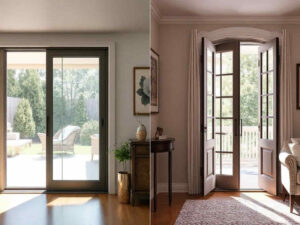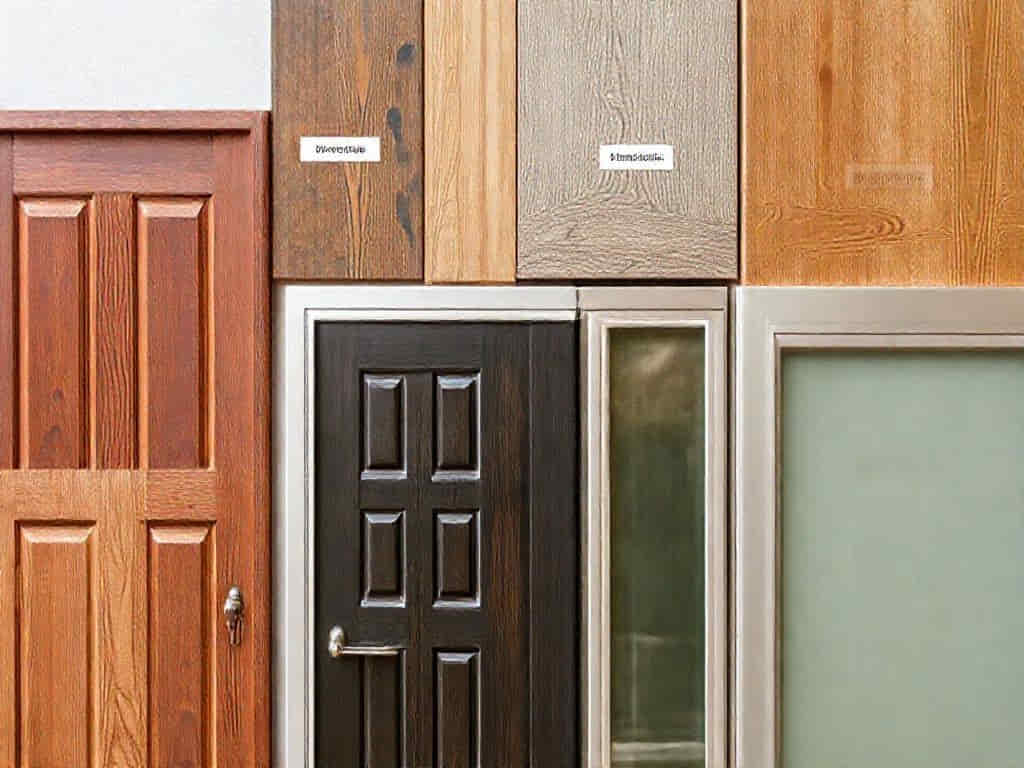
Your choice of doors can transform your home, affecting everything from aesthetics and security to energy efficiency and accessibility. Whether you’re considering sliding doors for their sleek design or hinged doors for their classic charm, it’s essential to understand the full range of factors that come into play.
This guide dives deep into materials, costs, accessibility, security, and maintenance to help you make an informed decision. And when you’re ready to install, working with a trusted doors installer near me ensures precision and long-term reliability.
Sliding Doors vs. Hinged Doors: Detailed Comparison
1. Space Efficiency and Use Cases
- Sliding Doors:
- Pocket Doors: Slide into the wall cavity, saving space and creating seamless room transitions. Popular for en suite bathrooms and pantry doors.
- Multi-Panel Systems: Ideal for large openings, these sliding doors connect indoor and outdoor spaces, perfect for patios or decks. High-end versions can feature automation and hurricane-rated glass.
- Barn Doors: Work well in tight areas like laundry rooms or small bedrooms, providing a rustic yet functional solution.
- Hinged Doors:
- French Doors: Elevate living or dining rooms with their timeless elegance, creating a sense of openness.
- Solid Core Doors: Provide excellent soundproofing, making them ideal for bedrooms, home offices, or media rooms.
- Custom Doors: Bespoke designs crafted from exotic woods with intricate detailing make for stunning entryways.
Takeaway: Sliding doors are space-saving and versatile, while hinged doors are better suited for traditional and grand designs.
2. Materials and Hardware: Pros and Cons
Materials and hardware play a vital role in a door’s performance, durability, and visual appeal. Here’s a deeper look at each option:
- Sliding Doors:
- Frames:
- Vinyl: A cost-effective choice with good insulation properties. Look for high-quality vinyl certified by organizations like AAMA for durability and UV resistance.
- Aluminum: Sleek and strong, but prioritize thermally broken aluminum frames to improve insulation in climates with temperature extremes.
- Wood: Provides a warm, premium look but requires regular maintenance. Sealing, painting, or staining is often needed every 1–3 years in humid or rainy climates to prevent rot or insect damage.
- Glass Options:
- Tempered Glass: Offers safety by breaking into small, blunt pieces upon impact.
- Impact-Resistant Glass: Essential for regions prone to hurricanes or extreme weather, providing both security and durability.
- Frosted or Patterned Glass: Balances privacy with aesthetics.
- Tracks and Rollers: High-quality stainless steel tracks and heavy-duty rollers ensure smooth operation. Watch for signs of wear or misalignment, as these can impact functionality.
- Frames:

- Hinged Doors:
- Wood Types:
- Solid Wood: Durable and luxurious, with species like mahogany and teak offering excellent resistance to weather and pests.
- Engineered Wood (MDF): Dense versions with veneer layers offer good moisture resistance and durability, though quality varies.
- Hinges:
- Ball-Bearing Hinges: Best for heavy doors, offering smoother operation and lasting durability.
- Security Pins: Prevent tampering by making it impossible to remove the door by pulling out hinge pins.
- Handles and Locks: Lever handles are ergonomic and meet ADA standards. High-quality deadbolt locks enhance security.
- Wood Types:
Takeaway: Choosing high-quality materials and hardware ensures durability, reduces maintenance, and enhances functionality. Consulting a professional for doors installation near me can help you evaluate these options.
3. Accessibility Considerations
ADA guidelines provide important benchmarks to make spaces accessible for all. Here’s what to consider:
- Sliding Doors:
- Wide panels allow easy wheelchair access.
- Level thresholds, no more than 1/2 inch high, reduce tripping hazards and improve accessibility.
- Automated sliding doors are an excellent option for hands-free operation.
- Hinged Doors:
- A clear opening width of at least 32 inches is essential for wheelchair users. Ensure the door frame and hardware don’t obstruct this clearance.
- Lever-style handles are easier to operate than traditional knobs.
- Provide sufficient maneuvering space on both sides of the door to allow for smooth navigation.
Takeaway: Thoughtful door design enhances usability and accessibility, ensuring convenience for everyone.
4. Security and Safety
The right security features protect your home and provide peace of mind.
- Sliding Doors:
- Multi-Point Locking Systems: Lock the door at several points for enhanced security.
- Anti-Lift Devices: Prevent the door from being lifted out of its track.
- Reinforced Frames: Aluminum or steel frames offer strength and resilience.
- Interlocking Meeting Stiles: Reduce gaps between sliding panels, improving both security and energy efficiency.
- Hinged Doors:
- Solid Door Frames: Ensure frames are securely anchored to the wall studs for maximum strength.
- Strike Plates: Use long screws (at least 3 inches) to secure strike plates to the studs, increasing resistance to forced entry.
- Security Hinges: Prevent tampering with non-removable hinge pins or concealed hinge designs.
Takeaway: Invest in robust locking mechanisms, reinforced frames, and secure installations to maximize safety. A doors installer near me can ensure these features are correctly implemented.
5. Maintenance and Cost Considerations
Costs vary widely based on size, material, customization, and installation complexity. Here’s a breakdown:
- Sliding Doors:
- Cost Range:
- Standard models: $500–$1,500.
- High-end multi-panel systems with automation or impact-resistant glass: $5,000–$15,000.
- Installation Costs: Typically $300–$1,000, depending on complexity and labor rates.
- Maintenance: Tracks require regular cleaning to prevent debris buildup. Rollers may need occasional replacement due to wear or misalignment.
- Cost Range:
- Hinged Doors:
- Cost Range:
- Basic hollow-core models: $150–$500.
- Premium custom solid wood doors with rare woods or intricate detailing: $3,000–$15,000 or more.
- Installation Costs: Typically $150–$800, depending on door size and hardware complexity.
- Maintenance: Exterior wood doors need periodic repainting or refinishing, especially when exposed to the elements. Lubricate hinges and adjust for sagging as needed.
- Cost Range:
Takeaway: While higher-quality doors and hardware come with a steeper price tag, they often save money in the long run through lower maintenance and greater durability.
Conclusion: Choose the Right Door for Your Home
Sliding doors bring modern elegance, space-saving functionality, and seamless indoor-outdoor transitions, while hinged doors offer timeless charm, excellent privacy, and unmatched versatility. Your decision depends on your specific needs, style preferences, and budget.
When you’re ready to bring your vision to life, visit a local showroom, request a custom quote, or consult a trusted doors installer near me for expert guidance. The right door, paired with professional installation, will enhance your home’s style, security, and convenience for years to come.

 December 31st, 2024
December 31st, 2024  Arnold
Arnold  Posted in
Posted in 